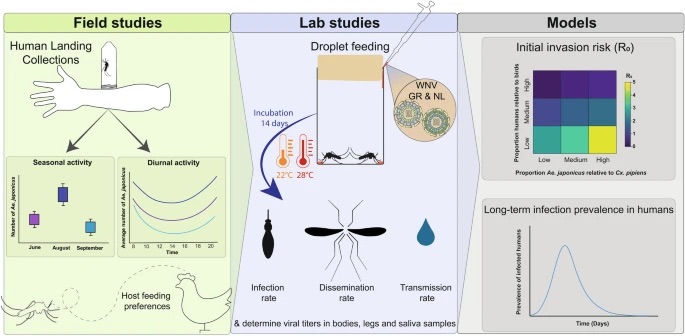The potential role of the Asian bush mosquito Aedes japonicus as spillover vector for West Nile virus in the Netherlands

Authors: Charlotte Linthout, Afonso Dimas Martins, Mariken de Wit, Clara Delecroix, Sandra R. Abbo, Gorben P. Pijlman & Constantianus J. M. Koenraadt
Background
In recent years the Asian bush mosquito Aedes japonicus has invaded Europe, including the Netherlands. This species is a known vector for a range of arboviruses, possibly including West Nile virus (WNV). As WNV emerged in the Netherlands in 2020, it is important to investigate the vectorial capacity of mosquito species present in the Netherlands to estimate the risk of future outbreaks and further spread of the virus. Therefore, this study evaluates the potential role of Ae. japonicus in WNV transmission and spillover from birds to dead-end hosts in the Netherlands.
Methods
We conducted human landing collections in allotment gardens (Lelystad, the Netherlands) in June, August and September 2021 to study the diurnal and seasonal host-seeking behaviour of Ae. japonicus. Furthermore, their host preference in relation to birds using live chicken-baited traps was investigated. Vector competence of field-collected Ae. japonicus mosquitoes for two isolates of WNV at two different temperatures was determined. Based on the data generated from these studies, we developed a Susceptible-Exposed-Infectious-Recovered (SEIR) model to calculate the risk of WNV spillover from birds to humans via Ae. japonicus, under the condition that the virus is introduced and circulates in an enzootic cycle in a given area.
Results
Our results show that Ae. japonicus mosquitoes are actively host seeking throughout the day, with peaks in activity in the morning and evening. Their abundance in August was higher than in June and September. For the host-preference experiment, we documented a small number of mosquitoes feeding on birds: only six blood-fed females were caught over 4 full days of sampling. Finally, our vector competence experiments with Ae. japonicus compared to its natural vector Culex pipiens showed a higher infection and transmission rate when infected with a local, Dutch, WNV isolate compared to a Greek isolate of the virus. Interestingly, we also found a small number of infected Cx. pipiens males with virus-positive leg and saliva samples.
Conclusions
Combining the field and laboratory derived data, our model predicts that Ae. japonicus could act as a spillover vector for WNV and could be responsible for a high initial invasion risk of WNV when present in large numbers.
Graphical Abstract
